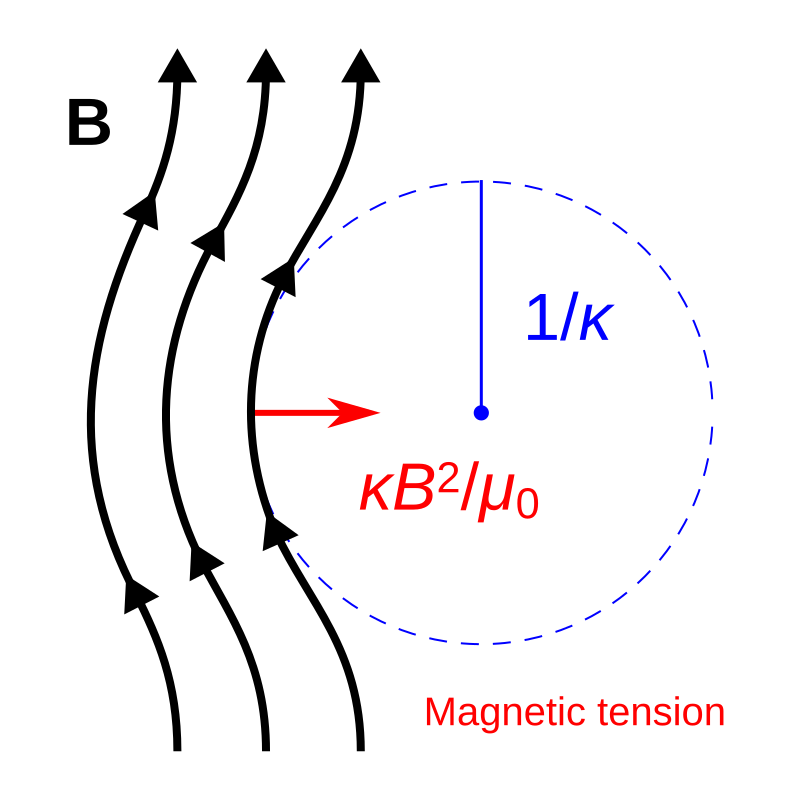John Carlos Baez on Nostr: Hardcore math post: After my spectacularly popular post on Alfvén waves, there's ...
Hardcore math post:
After my spectacularly popular post on Alfvén waves, there's nothing to do but write a much less popular post on the math behind them. People say magnetic field lines in a plasma can act like stretched rubber bands: if they're bent, they try to straighten out. There's a Wikipedia article on this idea, which is called 'magnetic tension':
https://en.wikipedia.org/wiki/Magnetic_tension#Mathematical_statementand I'd like to understand it.
They start with the equations of 'ideal magnetohydrodynamics' where you have a plasma with velocity vector field 𝐯, pressure p, density ρ and electric current vector field 𝐉 in a magnetic field 𝐁. It's called 'ideal' because we're assuming the plasma conducts electricity so well that the electric field is zero.
One of these equations, called the 'Cauchy momentum equation', says the plasma accelerates due to two forces:
the gradient of pressure, or more precisely −∇p, and
the force caused by the magnetic field, which is 𝐉 × 𝐁 as usual - this is called the Lorentz force.
They then do some fun vector calculus manipulations. Assuming |𝐁| is constant everywhere, they find a term in the force whose magnitude is the curvature κ of the magnetic field line, which points to the center of curvature of the magnetic field - where you approximate the magnetic field locally as going around a circle of radius 1/κ. See the picture to understand what the hell I just said.
I think I follow the calculation, but this is a force on the plasma, right? Not the magnetic field line per se! So why do they interpret it as the field line wanting to straighten out? If we knew 𝐯 is proportional to 𝐁 that would make sense, but they don't say anything about that.

Published at
2024-12-26 22:01:34Event JSON
{
"id": "31f33ae30e058c0c7c4a4bb10d97cdc1464040c94d51da43b84c2bd67de73e56",
"pubkey": "f7346eb283902ada9d21c109a93e83128d9f87d8fcfe70ad819b3bf2ad9bce16",
"created_at": 1735250494,
"kind": 1,
"tags": [
[
"imeta",
"url https://media.mathstodon.xyz/media_attachments/files/113/721/349/151/384/313/original/e3ad8806d7d78792.png",
"m image/png",
"dim 800x800",
"blurhash U5S$ig00%#~XTKR5i_XT%etSr?s8xVRQT0t4"
],
[
"proxy",
"https://mathstodon.xyz/users/johncarlosbaez/statuses/113721376383920130",
"activitypub"
]
],
"content": "Hardcore math post:\n\nAfter my spectacularly popular post on Alfvén waves, there's nothing to do but write a much less popular post on the math behind them. People say magnetic field lines in a plasma can act like stretched rubber bands: if they're bent, they try to straighten out. There's a Wikipedia article on this idea, which is called 'magnetic tension':\n\nhttps://en.wikipedia.org/wiki/Magnetic_tension#Mathematical_statement\n\nand I'd like to understand it. \n\nThey start with the equations of 'ideal magnetohydrodynamics' where you have a plasma with velocity vector field 𝐯, pressure p, density ρ and electric current vector field 𝐉 in a magnetic field 𝐁. It's called 'ideal' because we're assuming the plasma conducts electricity so well that the electric field is zero.\n\nOne of these equations, called the 'Cauchy momentum equation', says the plasma accelerates due to two forces: \n\nthe gradient of pressure, or more precisely −∇p, and\n\nthe force caused by the magnetic field, which is 𝐉 × 𝐁 as usual - this is called the Lorentz force.\n\nThey then do some fun vector calculus manipulations. Assuming |𝐁| is constant everywhere, they find a term in the force whose magnitude is the curvature κ of the magnetic field line, which points to the center of curvature of the magnetic field - where you approximate the magnetic field locally as going around a circle of radius 1/κ. See the picture to understand what the hell I just said.\n\nI think I follow the calculation, but this is a force on the plasma, right? Not the magnetic field line per se! So why do they interpret it as the field line wanting to straighten out? If we knew 𝐯 is proportional to 𝐁 that would make sense, but they don't say anything about that.\n\nhttps://media.mathstodon.xyz/media_attachments/files/113/721/349/151/384/313/original/e3ad8806d7d78792.png",
"sig": "02172566a7cbca36c2a2e23d8e5af77cec59a3e87240d6da1c7d938da424245baa067576e7cb5dd6059289559967b8a20541d980b716f34c2f47372549c48eb9"
}
